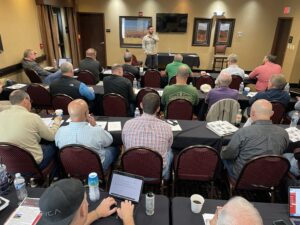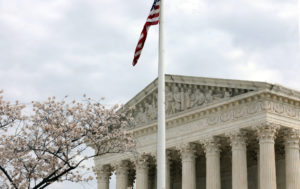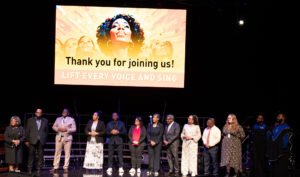
 On a Sunday afternoon in South Central Los Angeles, three congregations joined at Faith Missionary Baptist Church for a praise service that has become an annual tradition. For well over two hours choirs sang and speakers gave exhortation through devotionals – all focused on the glory of God.
On a Sunday afternoon in South Central Los Angeles, three congregations joined at Faith Missionary Baptist Church for a praise service that has become an annual tradition. For well over two hours choirs sang and speakers gave exhortation through devotionals – all focused on the glory of God.
Such a service is fairly typical in the black-church tradition, but the difference in this one was in their nontraditional denominational affiliation. In the heart of a neighborhood infamous for outbreaks of racial tension, these churches are enthusiastic partners in the Southern Baptist Convention – a denomination born in 1845 in defense of the right of missionaries to own slaves.
Ten years ago this month Southern Baptists restructured their Home Mission Board to specifically target the African-American community in church starting efforts – just as they have done for years with other language and ethnic groups. The move in many respects was a sign of changes already underway. But it also has been effective, helping move African-Americans increasingly toward the mainstream of Southern Baptist life.
"We started intentionally recognizing we had a responsibility to plant churches in every community, and not ask anyone else to do what God had called us to do," said Robert Wilson, national African-American specialist for the North American Mission Board's church planting group. The number of African-American churches has grown from about 1,200 in 1989 to an estimated 2,800 today, according to Wilson.
Los Angeles, like several other major metropolitan areas, presents one of the best case studies of change. The director of missions, Lyman Alexander, is African-American, as are more than half of the Crescent Valley Baptist Association's seventy-seven churches.
The transition in California began during the 1970s, Alexander said, when Southern Baptists efforts were based on the concept of "black church relations." It was recognized that blacks preferred their own conventions, but Southern Baptists could improve relationships and provide assistance to the black church through special training conferences and other activities.
In California, however, the result of improved relationships was that some churches began approaching Southern Baptists about affiliation.
"They began to say, 'We don't want to be out here talking about some relationships, we want to become a part of you,'" said Alexander.
By the early 1980s the state convention began moving toward a structure that helped develop new congregations and encourage new church starts, and by the end of the decade the transition was complete.
In California, as in other states, many of the new African-American churches were already existing churches and often dually aligned, but gradually the emphasis began moving toward starting churches from the ground-up as Southern Baptist congregations.
In many black churches, the pastor is the only professional staff member. He is supported by volunteer associate ministers, who receive ministerial training on an apprenticeship basis – a tradition Wilson said goes back to West Africa. In the new paradigm, that mentoring tradition is blended with the Southern Baptist emphasis on starting new churches.
Alexander – who formerly worked throughout the state helping start black churches – said it is a concept that made sense to pastors.
"Rather than waiting for the (associate ministers) to say that, 'I'm feeling a calling and I'm going to go off' … I would say, 'Pastor, begin encouraging them and begin training them with the idea that they are going to start a church," Alexander said.
Luther Keith, pastor of Central Baptist Church in Los Angeles, was no stranger to Southern Baptist life – having been pastor of the formerly majority-white congregation since 1974. And it was in 1989 that God first gave him the vision, he said, for a training center to train future ministers and church planters.
"The Lord put it on my heart to start a Church Planters Institute and gave me a burden to train and equip young pastors who had the call of God on their lives to go out and do Kingdom work," Keith said.
Assessment of personality types, mentoring, and intensive training were integral to his program, as was a belief that churches should be started with minimal outside funding.
The church has sponsored eight new works, including Faith Missionary and Rock of Ages. Only one – a Hispanic congregation whose pastor was forced to return to Brazil – no longer exists, Keith said.
A Common Heritage
The history of African-American Southern Baptists in California is fairly typical of the convention as a whole, at least in some of the larger metropolitan areas, Wilson said. It was during the 1950s that the first African-American church joined the convention in the modern era, but Wilson said the heritage of African-American Southern Baptists actually goes back to the SBC's founding in 1845.
Although they certainly weren't given voting rights in conventions or churches, slaves actually made up a third of the convention at the time.
"You had more blacks going to church at that period of time than Anglos," he said. "They were the bulk of the convention."
It was only later during the late 1800s that the freed slaves began forming their own Baptist congregations, and eventually their own convention.
"I believe that's one of the reasons we are growing at such a tremendous rate," Wilson said. "We are seeing that we are part of this heritage. There's a difference when I feel I am part of this than if I just came over here and I am a stepchild."
While some startup funds are often available, the primary advantages of SBC affiliation, pastors say, come from the training opportunities. In churches where pastors often lack graduate-level seminary training and Sunday school traditionally has been considered mostly for the children, those opportunities have made the difference.
"I'm trying my best to give the people what God's given me," said James Cross, pastor of Faith Missionary Baptist Church. "Whatever (training) Southern Baptists have to offer, if it will help the church I encourage them to go."
Cross, whose own training in ministry came later in life through Keith's ministry and other seminary extension courses, noted one upcoming training conference he was requiring all leadership to attend. "I don't always make the demands that they should go, but this is urgent," he said.
Planting Multiplying Churches
That emphasis on mentoring and training also has been critical for Elroy Barber, pastor of West Side Baptist Church in the Miami, Fla., suburb of Hollywood. The formerly Anglo church was essentially restarted in 1993 – from a core of about six or seven remaining members – with the express purpose of being a church-starting congregation. Today, twenty-two congregations with more than 2,800 members now trace their heritage to West Side.
Barber, who joined Southern Baptist ranks as a church planter in 1985, worked with the Gulfstream Baptist Association to develop West Side. An emphasis was placed on having multiple staff members for new church plants from the start, even if some of them were unpaid. Also, because of the importance Barber placed on training, Sunday school and adequate educational space were a priority.
"One of the major problems with African-American churches is that they build an auditorium and no educational space, and that's one of the biggest deterrents for growth," said Stewart Pickle, church extension director for the Gulfstream Baptist Association, which has used Barber's model as the basis for church planting efforts among African-Americans.
The model also allowed for multicultural growth, allowing West Side to plant churches to reach more than just African-Americans.
"We only preach in one language," Barber said, "but we pray in six languages."
Penetrating the Hip Hop Culture
One of the cultures West Side was able to reach was not even an ethnic group, but a subculture of young people for whom most worship services would seem absolutely foreign – the hip-hop culture. Two youth workers – Joel Stigale and Dave Web – connected at West Side and quickly began organizing. It began when a young man at West Side and another youth minister met at a West Side event. Soon, with the help of the association and state convention, they were organizing a massive evangelistic event known as Generation X Arise.
"That hip-hop culture is probably the number one thing with the young people down here. In other parts of the country it might be dance music or rock, but here the hip-hop culture is on top – and that crosses all races and languages," said Stigale.
The response was overwhelming. They began weekly meetings on Friday evenings. "We had forty decisions and sixty rededications in just a couple of months," Stigale said. The emphasis has shifted in recent months to a core group of about twelve to fifteen who often share their testimonies in churches and do break-dance demonstrations – helping others realize the need for addressing all segments of society with the gospel.
"These kids, they're hungry," Barber said. "They're not bad kids. But they need somebody to lead them. They need someone to share with them that they can be hip-hoppers and still love Jesus."
He admits that he would never reach them. "Could you see me trying to break dance?" he quips. "I tell them, 'You're my break-dancers.'"
He also is currently meeting regularly with Web, helping him explore his own calling to ministry and grooming him – just as he has with so many others – to someday plant a church of his own.
Inclusive by Design
Barber has another hat these days, one indicative of the inroads African-Americans have made into the Southern Baptist mainstream. He was elected last fall as president of the Florida Baptist Convention, a first for an "old-line" Southern state such as Florida. It was a reflection of a comprehensive change in thinking in the state convention that can be traced to a restructuring in 1994.
"They have said, 'We are going to make sure that we have the same organization to reach African-Americans, language people, and Anglos'," said NAMB's Wilson. " … So they have an Anglo state director of missions, a language state director of missions, and an African-American state director of missions."
Under each is a staff of specialist in such areas as church growth, church development, and church starting. The sizes of the staffs are more commensurate with the needs, but the structure ensures that work among non-Anglo groups remains a priority.
Barber acknowledged the structure is perceived by some as treating different groups separately, but he also said it is necessary. "For the time that we are living now this has to be done to include the African-American culture and bring that into Florida Baptists as a whole," he said. "Which simply means that we are being intentional. It is a holistic approach of blending this thing together in a real sense, and not just in the sense of a few dollars coming down."
The results testify to the approach's success, Barber said. Over the past five years, since the change was initiated, the number of African-American congregations has grown from just over 100 to nearly 300 today – with a goal of 500 new starts by the end of 2000.
Wilson lauds Florida's efforts as jump-starting a process of incorporating African-American leadership at all stages of Southern Baptist denominational life. Nationally, although not hard-wired into the structure, progress is also occurring.
Twelve state conventions have had blacks added to church planting staffs since 1994, with others on the way. Even then, he said, there is still a great need for African-American specialists on the association and regional levels to overcome the barriers – both real and perceived – that have separated churches by race for the past 100 years.
The SBC's 1995 resolution on racism went far in welcoming African-Americans to the table, Wilson said, and efforts of intentional inclusion in leadership continue the trend. While many Southern Baptists might consider racism a thing of the past – at least in the Southern Baptist family – African-Americans will tell you the subtle signals they receive regularly indicate true success has not yet been achieved.
"We still have places where people tell me, 'Before you plant a black church here many of us will have to die.' That's in 1998 that we have that, and only because of the perspective that they have," Wilson said. "That perspective has to be changed."















